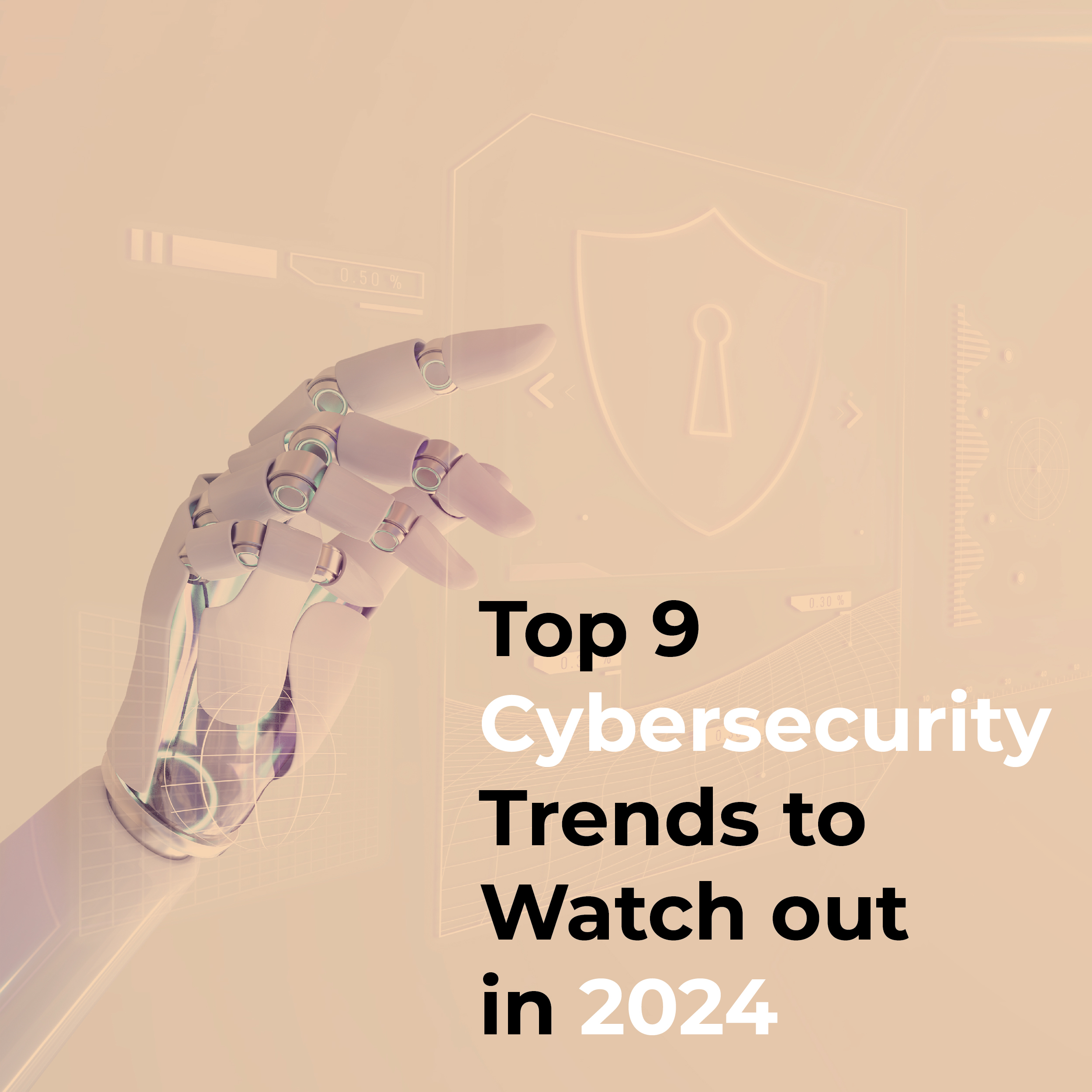Cyber threats are on the rise in 2024. A recent report by Cybersecurity Ventures predicted that the global cost of cybercrime will hit a staggering $10.5 trillion in 2025. These statistics indicate the critical need for organizations to prioritize their cybersecurity strategy.
Stating that owing to the improvement in technology, data leaks, ransomware, and hacking incidents are on the rise. New businesses, software, and devices will still need more robust data protection and completely new solutions.
Here are the top 9 Cybersecurity Trends in 2024
1. AI-Powered Cybersecurity
Artificial Intelligence (AI) and machine learning are changing cybersecurity by allowing real-time threat detection, projection, and response. These technologies allow security teams to easily detect possible threats, improving their capabilities.
Impact: With AI, organizations can take advantage of threat detection precision and faster response times, which reduce the chances of attacks. However, this also opens the door for cybercriminals to utilize AI for more refined attacks, pushing defenders to continuously adapt.
2. Zero Trust Architecture
The Zero-Trust approach, substituting traditional security models, works on the principle of “never trust, always verify.” This mandates continuous authentication and validation of every user, whether inside or outside the network.
Impact: Executing Zero Trust Architecture improves security across and hybrid and cloud environments, lowering the chances of unauthorized access and data leaks. Nonetheless, transitioning to the Zero Trust model requires organizations to rethink and redesign their security infrastructure, which can be tedious work.
3. Rise of Ransomware-as-a-Service (RaaS)
The dark web has given drift to Ransomware-as-a-Service (RaaS), allowing even non-expert hackers to cast ransomware attacks. This trend has democratized cybercrime, making it simpler for hackers to launch such attacks.
Impact: RaaS has led to a surge in ransomware attacks, affecting organizations of all sizes. As a result, businesses should brace their defenses, build solid backup solutions, and develop complete response plans to mitigate the effects of potential attacks.
4. Cloud Security and Compliance
As organizations move to the cloud, protecting these environments and ensuring compliance have become top priorities. The shift to cloud computing brings challenges like securing data across distributed channels and meeting strict regulatory requirements.
Impact: The growing demand for cloud security solutions reflects the need to protect sensitive data and maintain compliance with data protection laws. Failing to safeguard cloud environments can cause serious financial and reputational damage because of data leaks and regulatory penalties.
5. Supply Chain Attacks
Cybercriminals target supply chains as a way to penetrate larger networks. By compromising authorized third-party vendors, attackers can gain access to sensitive data and crucial infrastructure, possibly causing widespread damage.
Impact: Supply chain attacks have far-reaching effects, with a single compromised vendor potentially affecting entire networks. Organizations should implement stricter vendor management practices and improve supply chain security protocols to reduce the risk of such attacks and avoid operational disruptions.
6. IoT Security
The sudden expansion of the Internet of Things (IoT) has raised new exposures, making IoT security a vital concern. With billions of connected devices in use, the attack surface has rapidly grown, providing cybercriminals with more chances to exploit weaknesses.
Impact: As IoT devices become more prevalent, protecting them is important to avoid unauthorized access and data breaches. Organizations must invest in strong IoT security measures like encryption, device authentication, and network segmentation, to stay secure against possible threats.
7. Quantum Computing Threats
Quantum computing has the potential to revolutionize technology but also holds a threat to current encryption methods. Quantum computers can break traditional encryption algorithms, inducing them ineffective.
Impact: The threat of quantum computing can compromise the security of sensitive data if organizations don’t train for the post-quantum era. To protect information, businesses must start exploring and adopting quantum-resistant encryption methods, ensuring they are prepared when quantum computing becomes a reality.
8. Increased Regulatory Pressure
Governments and regulatory bodies are imposing stricter cybersecurity regulations and data protection laws. These regulations aim to improve data privacy and security, but they also place a compliance burden on businesses.
Impact: The growing regulatory pressure needs organizations to invest in compliance measures to prevent penalties and assure data protection. Non-compliance can cause severe financial penalties and reputational damage, making it crucial for businesses to stay informed about and stick to evolving regulations.
9. Human-Centric Cybersecurity
Human behavior remains one of the most vital factors in cybersecurity. Recognizing this, organizations are concentrating on human-centric cybersecurity techniques that highlight training, awareness, and threat management.
Impact: Addressing both technological and human vulnerabilities allows businesses to improve their overall security measures. By investing in employee training and awareness programs, organizations can lower risks associated with human error and insider threats, leading to a more secure and resilient operation.
To improve security, we can consider mandatory security certifications for new devices, encryption, and standardized security protocols. However, it’s vital for customers to make conscious decisions to only use IoT devices that meet security standards. Other techniques like edge computing can filter sensitive information and enhance the overall security of IoT devices.
By using the latest technologies and making Cybersecurity a top priority, you can protect your organization against cyber threats. This involves implementing zero-trust networks that require explicit authentication and limit lateral movement. Additionally, consider using passkeys and passwordless technologies to secure your networks. Remember, it’s always wise to assume that a determined hacker could potentially encrypt and steal your data.
